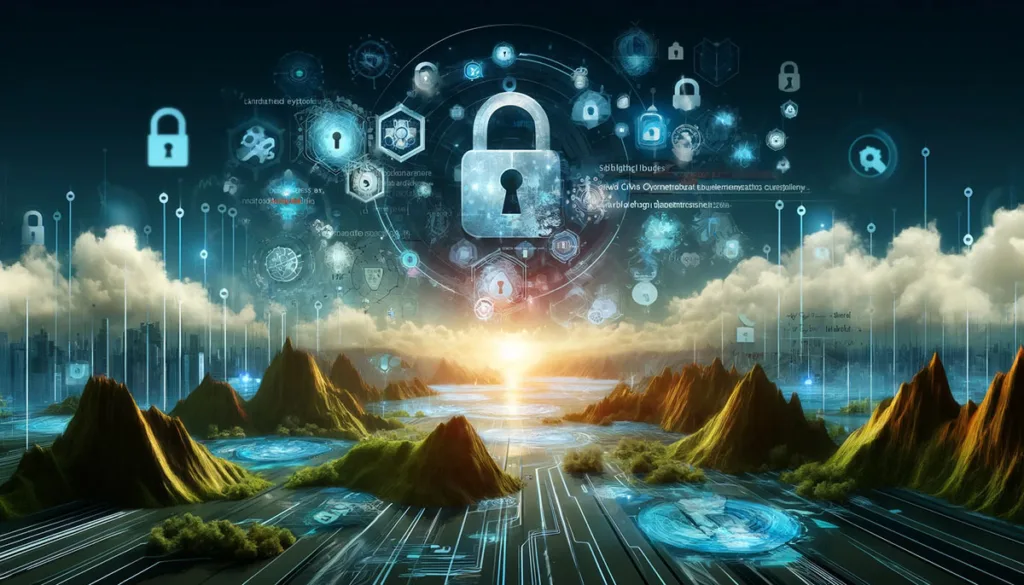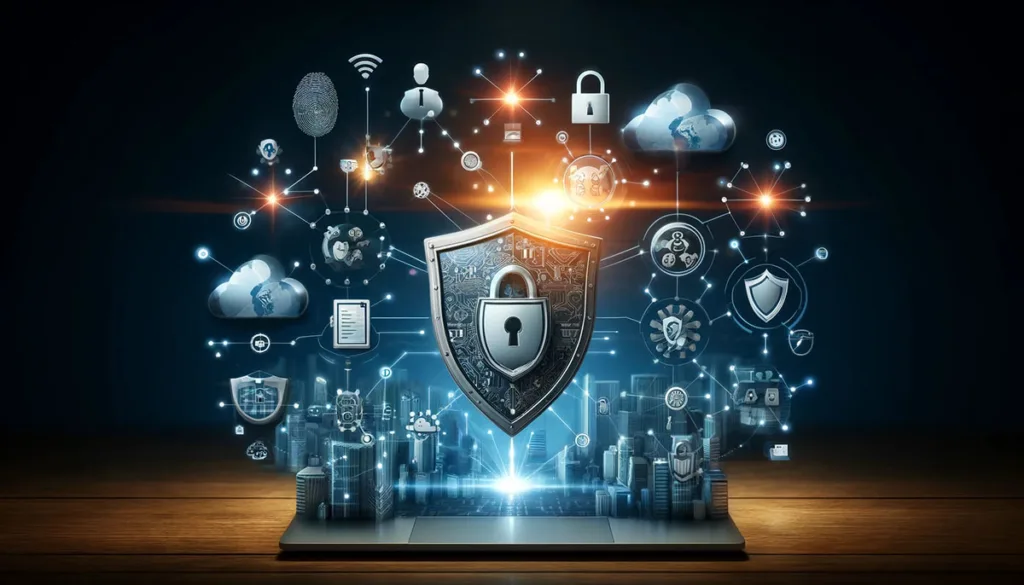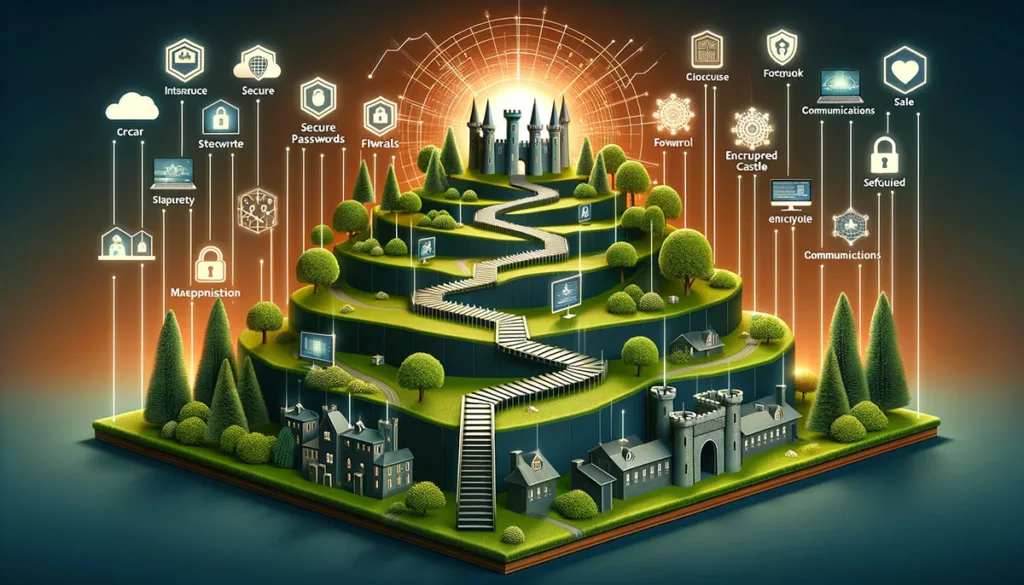The digital era has transformed our daily lives, reshaping how we communicate, work, and interact. The rise of digital technologies and the internet’s essential role have highlighted cybersecurity’s critical importance. It is becoming increasingly important to protect company and personal data from cyberattacks. This article explores the cybersecurity landscape in our digital era, identifying key challenges and providing practical solutions to defend against these dynamic threats.
Understanding Cybersecurity Challenges

The Evolving Threat Landscape
Cybercriminals are perpetually refining their tactics, leveraging sophisticated techniques to exploit vulnerabilities. Cyber threats, including malware, ransomware, and phishing, are growing more complex, posing increasing challenges to safeguarding sensitive data. Recent data shows a notable increase in cyberattacks, emphasizing the urgent need for solid cybersecurity defenses to counter these shifting threats.
Types of Cyber Threats
- Malware: Harmful software aimed at damaging or exploiting devices, services, or networks.
- Ransomware: This malware encrypts a victim’s files, with attackers demanding a ransom for data restoration.
- Phishing: The practice of sending false emails that look to be from reputable sources in an attempt to obtain personal data, such as login passwords and credit card numbers.
Statistics on the Rise of Cyberattacks
There has been a marked increase in cyberattacks, with a 2021 report from a cybersecurity firm indicating a 50% rise in the weekly average of attacks per organization over 2020. This worrying trend underscores the critical importance of bolstering cybersecurity defenses.
Vulnerabilities in Modern Technologies
Adopting modern technologies introduces new cybersecurity vulnerabilities. Despite their efficiency and convenience, cloud computing and the Internet of Things (IoT) pose unique security challenges that must be addressed to prevent unknown threats.
IoT Devices
The Internet of Things encompasses interconnected physical objects equipped with technology to exchange data over the Internet. Despite their benefits, many IoT devices are not sufficiently secured, making them vulnerable to cyberattacks.
Cloud Computing Vulnerabilities
Cloud computing has changed data storage and processing, offering scalability and cost savings. However, the transition to cloud storage complicates data security, with concerns including shared resources, data breaches, and insecure interfaces.
Human Factors and Cybersecurity
Humans significantly impact cybersecurity. Social engineering, which relies on human interaction to gain or compromise information, remains a significant threat. Therefore, educating people on cybersecurity’s importance and providing training is crucial to establishing a solid defense against cyber threats.
The Role of Social Engineering
Social engineers manipulate individuals to access confidential information for fraudulent purposes. Techniques such as phishing emails and pretexting exploit human vulnerabilities.
Importance of Cybersecurity Awareness and Training
Training and awareness of cybersecurity practices are vital in reducing cyberattack risks. Informing employees and the public about social engineering dangers and recognizing phishing can significantly diminish the success rate of these attacks.
This section establishes the framework for a detailed analysis of cybersecurity issues and remedies in the modern era. By grasping the changing threat landscape, acknowledging the vulnerabilities brought by new technologies, and understanding the influence of human factors, we can equip ourselves to confront these challenges effectively.
Key Cybersecurity Challenges in Detail

Data Breaches and Privacy Concerns
Data breaches are increasingly common, significantly impacting businesses and making headlines. These incidents damage people’s reputations, erode trust, and cause significant financial losses. Privacy concerns have surged with personal information, which is now a valuable asset, leading to growing apprehension about data handling and protection.
Case Studies of Significant Data Breaches
The Equifax breach in 2017 is a stark reminder of the potential consequences of such incidents. Sensitive information, including the Social Security numbers and birth dates of about 147 million people, was stolen, exposing severe consequences for security and privacy.
The Impact of Breaches on Businesses and Individuals
Businesses face numerous challenges after a data breach, including regulatory fines, legal repercussions, and the intangible cost of eroding customer trust. Individuals affected by data breaches are at risk of identity theft, financial losses, and various privacy issues.
Compliance and Regulatory Challenges
As cyber threats grow, so do the laws and regulations to stop them. Following these rules is not just about meeting legal standards; it’s key to a company’s cyber defense strategy. The financial penalties for not adhering to these rules can significantly affect a company’s finances.
Overview of GDPR, CCPA, and Other Regulatory Frameworks
The General Data Protection Regulation (GDPR) and the California Consumer Privacy Act (CCPA) stand out as regulations impacting how businesses manage personal information. The GDPR affects any entity operating within the EU or dealing with EU citizens’ data, focusing on personal data rights. The CCPA gives those in California similar rights over their personal information.
The Cost of Non-Compliance for Businesses
Ignoring these data protection laws can lead to substantial fines. For example, breaking GDPR rules might result in fines of up to €20 million or 4% of the worldwide revenue from the last financial year, whichever is greater. The harm to a business’s reputation can worsen these financial losses, highlighting the importance of following these regulations.
The Complexity of Securing Remote Work
The shift to remote and hybrid work models, sped up by the COVID-19 pandemic, has introduced new cybersecurity hurdles. Securing remote workspaces has become difficult as employees log in from different locations and devices.
Security Risks Associated with Remote and Hybrid Work Models
Remote work setups often need to pay more attention to the strong security measures of traditional office environments. Using personal devices for work purposes, unsecured home Wi-Fi, and the hurdle of securing various locations heighten the risk.
Best Practices for Securing Remote Workers
To lower these risks, companies should implement several security steps, such as secure VPN connections, endpoint security solutions, and ongoing security education for staff. Having clear remote work policies and continuously scanning for security threats is vital.
Cybersecurity is laden with obstacles, from cyberattack threats to compliance hurdles and the challenge of protecting remote teams. Tackling these issues demands a thorough risk understanding and an active stance on cybersecurity.
Cybersecurity Solutions for Businesses and Individuals

Cybersecurity affects IT specialists and individuals in the current digital era and is crucial for both. Meeting these challenges involves technology, awareness, and strategic planning.
Proactive Threat Detection and Management
With sophisticated cyber threats on the rise, waiting to react is no longer enough. The ability to identify and address threats before they cause damage is vital.
Introduction to SIEM and SOC
Security Information and Event Management (SIEM) technologies offer real-time security alert analysis from applications and network hardware. Security Operations Centers (SOCs) monitor, evaluate, and defend enterprise information systems. Using SIEM technology alongside SOC expertise provides a strong defense against cyber threats.
Implementing Strong Firewalls and Antivirus Solutions
Every cybersecurity strategy should start with strong firewalls and antivirus programs. Firewalls act as a shield between your secure network and less trustworthy external networks, like the Internet. Antivirus software looks for and removes malware and other online threats from your computer.
Implementing Strong Cyber Hygiene Practices
Cyber hygiene encompasses routine practices to maintain system health and secure an online presence. These steps help protect identities and sensitive details from theft or damage.
The Importance of Regular Software Updates and Patch Management
Regular software updates are a simple yet effective way to lower cyber risks. Updates and patches fix security weaknesses and defend against malware. Systems that automatically update and manage patches can keep software updated without hassle.
Creating Strong, Unique Passwords and Using Multi-factor Authentication (MFA)
Creating strong, unique passwords is crucial for account and information security. Multi-factor Authentication (MFA) enhances security by requiring multiple verification steps to access an account, significantly reducing the chance of unauthorized access.
Developing a Comprehensive Cybersecurity Strategy
A detailed cybersecurity strategy is essential for individuals and businesses, outlining how to defend against cyber threats.
Steps to Create a Cybersecurity Framework for Businesses
- Identify: Pinpoint which assets need protection.
- Protect: Apply steps to guard those assets.
- Detect: Set up ways to notice potential security events.
- Respond: Have a plan ready for dealing with security incidents.
- Recover: Plan to restore any impacted services or capabilities after a cybersecurity incident.
Incident Response Planning and Disaster Recovery Strategies
The impact of a cyberattack can be significantly reduced with a well-thought-out incident response and disaster recovery plan. These plans should detail specific actions for a breach, including how to communicate and recover.
Cybersecurity is vital and demands action from both individuals and organizations. By grasping the threat landscape and enforcing strong security practices, we can significantly lower the risk of cyberattacks.
Step-by-Step Guide to Enhancing Your Cybersecurity Posture

Moving through today’s digital environment requires an active stance on cybersecurity to shield personal and business assets from growing cyber dangers. This detailed guide provides practical steps for individuals and organizations looking to strengthen their cybersecurity defenses.
For Individuals
Boosting personal cybersecurity starts with simple yet vital steps to shield home networks, devices, and sensitive data from unauthorized entry and cyber threats.
- Secure your home network: The first critical move is to protect your home network’s entry point. Replace your router’s default login details with strong, unique credentials. Switching on WPA3 encryption adds a strong security layer to your Wi-Fi, complicating data interception by attackers. Updating your router’s firmware is crucial, as updates often fix security loopholes.
- Protect your personal devices and information: Your devices are portals to your private data. Installing antivirus programs from trusted sources is key for detecting and clearing malware. Turning on your device’s firewall is a defense against unauthorized access, and paying attention to the links you click and files you download can avert phishing and malware.
- Stay informed about the latest cyber threats: The fast pace at which cyber threats change makes it essential to keep up with new dangers and defense strategies. Signing up for cybersecurity updates, attending online security sessions, and following security experts on platforms like LinkedIn or Twitter are good strategies for staying ahead.
For Businesses
Companies face intricate security challenges, necessitating a systematic strategy to spot risks, train staff, and refresh policies as cyber threats evolve.
- Conduct a cybersecurity risk assessment: Conducting a deep dive to understand your company’s weak spots and threats is a fundamental step. This involves pinpointing crucial assets, potential dangers to these assets, and exploitable weaknesses. Evaluating the risk linked to each weakness aids in aligning security measures with their potential business impact.
- Train employees in cybersecurity best practices: Mistakes by people are a significant security risk for firms. Teaching staff to recognize suspicious emails, the importance of complex passwords, device security, and compliance with the company’s security rules is vital. Consistent, interactive training can significantly lower the chance of breaches due to employee errors.
- Review and update cybersecurity policies regularly: Revising your cybersecurity strategies frequently is critical with new technology and evolving cyber dangers. Staying updated with the latest threats ensures your company remains protected. Input from security assessments, staff suggestions, and industry standards should guide your policy updates to maintain effective defense measures.
Conclusion
While the digital era offers vast possibilities, it poses serious security challenges. Both individuals and businesses must take proactive measures to enhance their cybersecurity against a broad range of cyber threats. Following the guidance is a key step toward securing your digital activities. Our online spaces can be protected from cyberattacks by implementing comprehensive cybersecurity protocols and cultivating a culture of security awareness.

